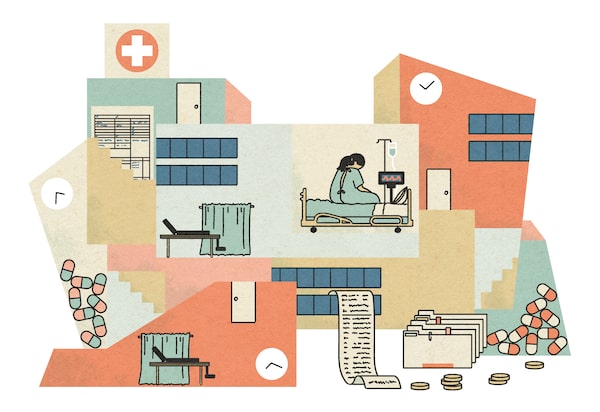First Person is a daily personal piece submitted by readers. Have a story to tell? See our guidelines at tgam.ca/essayguide

Illustration by Catherine Chan
It’s not easy being rare.
I’ve dealt with a rare medical issue all my life – a large, inoperable cerebral Arteriovenous Malformation (AVM); a tangled bundle of useless and fragile blood vessels in my brain that, in my younger days, tended to unexpectedly rupture. Before a few courses of radiation managed to toughen up and strengthen the vessels, seemingly anything – a sneeze, a bowel movement, exercise, blowing up a balloon, good sex – could trigger a brain bleed.
In all, I’ve had nine bleeds, or hemorrhagic strokes – some big, some small. I do all I can these days to avoid crossing over into the double digits on that count. Not only do they really, really hurt, but I’m not quite sure I can come back from one as well as I did 20 years ago, when most of my troubles occurred.
So, knock on wood and all that …
I’ve recently discovered, however, that I’ve graduated from rare to ultrarare in the medical realm; that all those hemorrhages from years ago have come back to haunt me. I am now dealing with something called Superficial Siderosis (SS), which, to keep it short, simply means that my body was unable to process all the blood that once poured into my brain, and the iron from that leftover blood has been lodged on my cerebellum, and in my spine, ever since … slowly attacking and eroding the nerves that are found there.
I diagnosed myself with Superficial Siderosis. I just want to make that clear.
In 2020, I noticed the unfamiliar term while I was looking over an imaging report. I Googled it and found an answer to all the troubling symptoms I’d been dealing with. Vague, weird, intermittent complaints that have been getting increasingly bothersome, especially in the last five years or so.
Chronic headaches, tinnitus, cognitive issues.
Loss of smell, taste, hearing, difficulties swallowing.
Disequilibrium, ataxia, bladder and bowel issues.
It was bittersweet, to finally figure it out. On one hand, I had an answer. On the other, it was a disturbing one.
Superficial Siderosis is degenerative, you see. As disheartened as I was by all I was reading about the disorder, I was also relieved to learn that there are ways (medication, antioxidant protocols) to potentially delay, or halt, its progression.
My relief was short-lived.
A diagnosis that you discover in consultation with Dr. Google is not well received in the medical community – even if you do have an extensive background in nursing, research and journalism.
One doctor told me to stop, implying that I was manifesting the symptoms I found online. One told me to move to America because health care is better there. One acknowledged the condition but wanted nothing to do with the medication I wished to try; another told me to go home and stop worrying. And, at a time when far too many people are struggling to find a family physician in this country, I walked away from mine. I quickly learned to work with only those doctors who take the time to listen, collaborate and, maybe most importantly, are kind.
To strengthen my argument, I paid out of pocket for a second opinion from a prominent neurologist who specializes in SS at Massachusetts General Hospital in Boston. He confirmed the diagnosis and recommended the use of a specific medication, an iron chelator (removes iron) that crosses the blood brain barrier.
I also became Canadian Director of the Superficial Siderosis Research Alliance and began to virtually meet monthly with people all over the globe who are working together to raise awareness of this disease, fundraise and support medication trials and studies.
And finally, a few key specialists began to listen, attitudes began to shift and things began to move forward.
Now, more than three years after I first learned what was causing my weird neurological issues, I am on the only known medication that may help. Now, more than three years since I began screaming to be heard in a medical system that is so busy trying to put out past fires that it seemingly has no time to prevent future ones, I have a medical team behind me that I can talk to and trust.
And for that, I am beyond grateful.
Still, it shouldn’t have been so hard. It shouldn’t have taken so long.
I’ve since learned, however, that three years is a relatively short delay in the rare disease community.
When it comes to rare conditions, Canada lags woefully behind many countries in terms of knowledge, diagnoses and treatments. The Canadian Organization for Rare Disorders (CORD) website states, “Right now, only 60% of treatments for rare disorders make it into Canada and most get approved up to six years later than in the USA and Europe.”
This must change.
And so, I write this essay in recognition of Rare Disease Day (Feb. 29). And I will be attending the CORD Rare Disease Day 2024 Summit in Ottawa this year.
Because if all of us – those who are personally on a rare disease journey – get involved and speak up loud enough, perhaps it will change.
Perhaps one day, it will be easier to be rare.
Brenda Lloyd lives in Frankford, Ont.